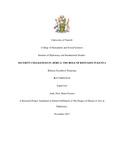| dc.description.abstract | With the increasing rate of insecurity across African continent especially terrorism as a result of massive refugee influx, many of African countries are worried about the impact the refugees have on the national security of the countries they seek asylum. This concern prompted me to carry out my research on the security challenges in Africa focusing on the role of refugees in Kenya. I was guided by the following set of questions: What is the impact of refugee influx on African security? What has been the trend and impact of refugee influx on Kenyan security? And what strategies and mechanisms has the Government of Kenya employed to combat insecurity especially terrorism as a result of refugee influx in Kenya? which were used to formulate my objectives: To examine and analyze the impact of refugee influx on African security; to examine and assess the trend and impact of refugee influx on Kenyan security; to analyze strategies and mechanisms the Government of Kenya has employed to combat insecurity especially terrorism as a result of refugee influx in Kenya. Securitization theory was used as the analytical tool for this research to help understand why refugees, typically seen as a non-security issue, a humanitarian concern, are presently viewed as potential threats to national security. I proceeded with these set of testable indicators: Massive refugee influx has generally had negative impact on African security; refugee influx in Kenya has increased insecurity; the perception that refugees are a major driver of terrorism has weakened counter terrorism efforts in Kenya. Mixed methods was used as the research design where both qualitative and quantitative methods were employed. According to the research findings, it was quite clear that, refugees are perceived as potential threats to security in Kenya, and the perception that they are a major driver of terrorism has weakened counter terrorism efforts in Kenya. From the study, many of the respondents felt that refugees were synonymous to terrorism, that the refugee camps provide breeding grounds for the terrorist groups including being avenues for radicalization and violent extremism for the combatant. A large number of those interviewed felt that Kenya’s porous borders have been taken advantage of by refugees entering into Kenya and proliferation of small arms and light weapons mostly used to train vulnerable refugees in the camp. This study will hopefully contribute in enriching the already existing literature especially on the nature and the extent of the refugee threat on host-country’s security in Africa at large and Kenya in particular. The recommendations of the study will hopefully provide information to policy makers which will go a long way to enhance security policies formulation and implementation. Among the recommendations put forth include enhancing border security, through refugee inspection or even the abolishment of the refugee camps and a joint community approach to fighting terrorism by way of inclusion of all the relevant stakeholders in both the public and private sectors. The suggested areas for further research are as follows: The role of porous borders in promoting insecurity in Africa and the feasibility of joint community, public and private sector in combating insecurity especially terrorism in Africa. | en_US |



